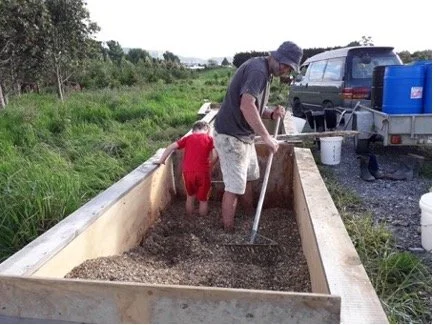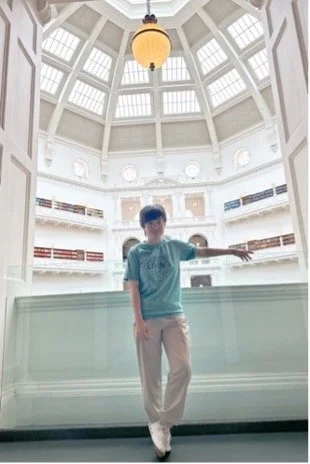Moe mai rā, haere rā, Dame Joan Metge, the founder of this Fund.
We received seven applications, all of which were eligible, and each received funding of up to $300 for assistance with conference presentations at ASAA/NZ 2025. The applications came from students at Otago, Victoria, Massey and Auckland universities, who were studying for BA Hons, Masters and Doctorates.
Many thanks to all the supervisors who provided letters of support: Eli Elinoff, Susan Wardell, Jesse Hession Grayman, Lorena Gibson (twice), Nina Harding, Callie Vandewiele, and congratulations to all the recipients and all of their supervisors. Thank you to the Kākano committee, Fiona, Jacs and Barbara, and to Lorena who turns this into our social media format.
Enjoy!
Profesor Julie Park, Kākano Fund Chair
Reha Kumar
Hau of Yoga: using Mātauranga Māori to Sustain an Indigenous Indian Practice
Yoga is an ancient Indian practice that invites inquiry into the self and motivates us towards peace internally and outworldly. Yoga has transitioned from the East to the West and gained global popularity. This has led to its detachment from its Indian spiritual roots to adoption as a commodity. Appropriation has replaced appreciation. I draw on the concept of Hau embedded in Mātauranga Māori (Māori knowledge) to argue that Yoga does not belong to everyone; rather, it belongs to India and is a gift to the world. Hau can mean wind or breath, but is also understood to be the life force that creates reciprocal relationships between people and the world. The hau that yoga practitioners embody is a taonga (treasure) with a whakapapa (genealogy). Indians are the kaitiaki (guardians) of yoga. When yoga is decontextualised and commodified, it loses the connection to the people from whom the practice comes.
Julia Watkin
Restorying youth mental health with a group of rangatahi in Aotearoa
My PhD project, a grounded patchwork ethnography narrative, has followed the winding path of a history, story, and restorying of youth mental health in Aotearoa. Along the way, I’ve picked up words and wording, from the media, from research, and from a group of rangatahi themselves, and woven them into vignettes and narratives that tell different stories of how young people understand and experience their mental health journeys. This presentation will speak to the connected methodologies I’ve chosen to work with and share how they’ve allowed me to express the research in ways that feel genuine to the young storytellers, honouring what makes their experiences individual and also what brings them together.
Clare Collins
On the edges of food charity: Volunteering as an act of concealed kindness
As humans, we are constantly making and remaking our own worlds. One of the ways some choose to do this is through voluntary labour. Much of the anthropological literature on this topic is focused on reciprocity and ‘the gift’, or the ways in which people form their own identities and gain cultural capital through this form of labour.
However, these explanations did not fit so neatly with the motivations of a group of volunteers at a local food rescue with whom I began my research in 2021. The work these volunteers do is not front-line. They do not have direct contact with those they are helping. Instead, it is quiet, repetitive, physical labour, often in solitude or with one other person. Every week they collect heavy boxes and bags of surplus food from supermarkets and deliver it to various community centres, interacting only with the staff there, not with the recipients of the food themselves. They do not receive admiration, reciprocal gifting, or direct appreciation from those they are providing a service to.
Based on participant-observation and semi-structured interviews, I will use theories of the anthropology of the good, and Clara Han’s concepts of concealed kindness, to suggest that there are other ways for us as anthropologists to view altruistic behaviour. We are all making and remaking our worlds, but perhaps we have been underestimating how much those working on the edges are making worlds for others.
Karissa Trainor
In-between Gendered Filipino Spaces of Inclusion and Exclusion
This paper uses photo-voice and kwentuhan to explore how the Filipino migrant community in Aotearoa experience belonging within Filipino spaces. The use of photo-voice and kwentuhan in this project is used to frame these interconnected experiences in a way that supports Filipino ways of sharing and interacting with one another. Photo-voice is a method that invites participants to photograph their personal everyday experiences to illustrate the relationship between their own experiences and the social and political world. The aim of this project was to unpack how gendered spaces can embody both inclusive, and exclusive cultural values and beliefs. In this paper, I will be analysing various stories from the Filipino migrant community here in Aotearoa, with the aim to understand the shared values, and beliefs that underlie these spaces and connect these disparate experiences. General themes that emerge across these stories include Catholicism, Utang na Loob and Social/Cultural Capital.
Sophie Gainsford (ASAA/NZ intern)
50 years of ASAA/NZ: Reflections on Researching a History of the Association
Earlier in 2025, I completed a trimester-long internship project with ASAA/NZ as part of my Honours degree in the Cultural Anthropology Programme at Te Herenga Waka—Victoria University of Wellington. The internship involved creating a comprehensive timeline of key dates and milestones in ASAA/NZ’s history. This project took on additional significance when we realised it coincided with the association’s 50th anniversary, making the timing particularly apt for commemoration and reflection. In this paper I offer a reflexive analysis of the research process involved in constructing this timeline and my broader internship experience, providing insights into ASAA/NZ from a newcomer’s perspective. I discuss the methods I used (interviews with ASAA/NZ members and archival research), some of the challenges I encountered, and highlight several notable features that emerged from the timeline, including ASAA/NZ’s Code of Ethics, the Association’s historical sense of justice, the longstanding and ever-evolving relationship between Māori and ASAA/NZ, and the broader discipline of anthropology in Aotearoa New Zealand that the Association represents.
Rowan McCormick
Title: Auto-construction in Aotearoa
The anthropology of auto-construction has tended to focus on informal self-built housing developing conspicuously and at scale in the urban peripheries of the Global South. Importantly, self-builders have been attributed political nous and qualities of resilience for their capacity to organise social and material resources as they make homes. Meanwhile, rural, peri-urban and off-grid building has tended to remain peripheral in the literature, eclipsed perhaps by urbanists’ preoccupations with intensity, dazzle and scale.
In this paper I use the motif of the invisible city (after Calvino) to think collectively about the dispersed, diffusely situated, yet variously connected practices of auto-construction in Aotearoa. Based on my PhD research with self-builders and alternative housing providers, I discuss how this invisible city builds from the hopeful aspirations for a better life, and with the material and human castings of real estate capitalism. I ask how an anthropology of these edgy, concealed, and often geographically and strategically ‘invisible’ building practices can contribute to how we sense and see broader relationships between places and people during critical times.
Alison Meiting Wang
Designing Care in China: Investigating Care Ethics and Developer Responsibility in Mental Health AI
(Alison) Meiting
This paper explores the ethical lives of frontline developers in China’s AI mental health sector. Based on 24 in-depth interviews and a Foucauldian discourse analysis of user agreements, policies, and product texts, this ethnography examines how practitioners design “care” amidst regulatory ambiguity. The research reveals a “dual discourse”: AI is framed as a “tool” in agreements to sever liability, yet packaged as a “companion” in the market to mobilize emotion. In practice, developers create a “makeshift ethics” defined by a defensive logic of risk amputation that equates care with scale. Responsibility circulates competitively between users, platforms, and an imagined state backstop, forming a distributed network. Focusing on these negotiations, this study argues that the future of algorithmic governance is forged not in boardrooms but in the everyday compromises at its edges, creating a new system where care and control become deeply intertwined.
This year the ASAA/NZ Conference will be held in Whāingaroa Raglan between December 9-12, 2025.









